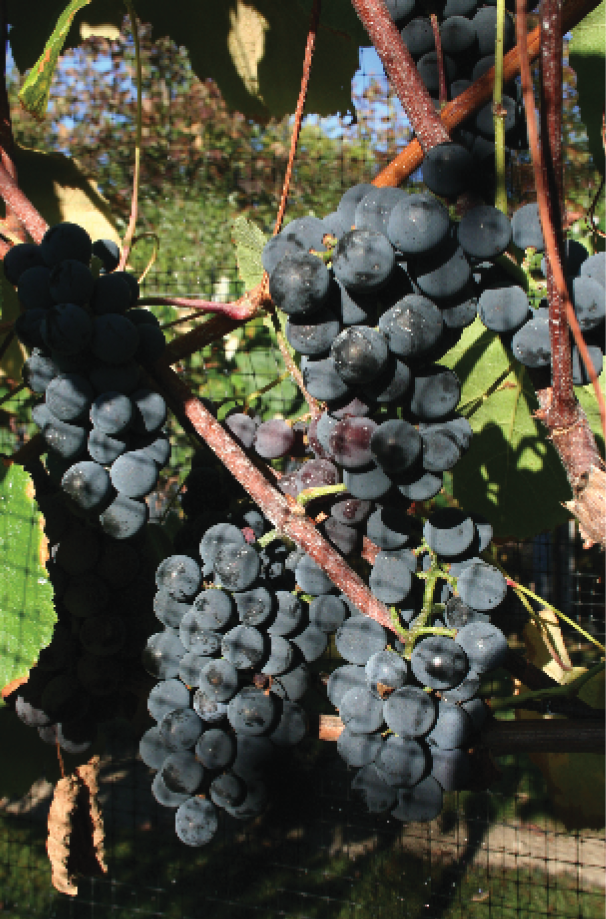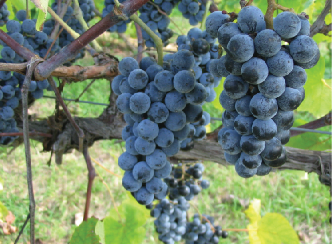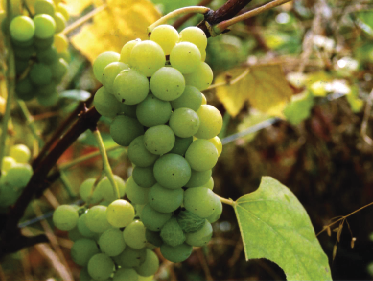
Botanists tell us that grapes are members of the genus Vitis, and the well-known European grape varieties are members of the species vinifera. (In case you’ve forgotten, a species is one rung lower in the botanical classification system than a genus.) When the Europeans first came to the New World, they found grapes growing in great profusion here, but these New World grapes were all members of different species than those members of the species vinifera with which they were familiar from home. Whereas botanists and taxonomists are still trying to determine exactly how many different species of grapes there were in North America at the time of its discovery, the number is in the range of 20 to 30, and one of them is the species labrusca. It would be hard to argue that Vitis labrusca is anything less than a native species of grape in North America. Among the other grape species native to North America are riparia, aestivalis, rotundifolia, and mustangensis. However, if a hybrid is formed by the union of a native species of grape with a non-native species, that hybrid’s claim to the “native” descriptor is less clear — even if the hybrid exhibits many of the characteristics of its native parent.
In this article I will attempt to point out some of the issues I find interesting as we go through each of the grape cultivars I selected, which are addressed generally in chronological order based on their discovery or development. Some of these grape cultivars are of uncertain origin, with unresolved questions relative to their dates of origination, the persons responsible for their existence, and the new vines’ parentage.
Alexander
Hedrick described this grape as, “The first variety to be grown in a commercial scale in eastern America.” The vine was an accidental hybrid between some imported Vitis vinifera vine in the garden of William Penn (of Pennsylvania) and a wild Vitis labrusca somewhere around 1740. The cultivar was named after Penn’s gardener, James Alexander.
Catawba
There is some question as to the time, location, and person responsible for the recognition and/or development of the Catawba grape. Evidence suggests it may have originated as early as 1801 in western North Carolina where there was a river, a county and a Native American tribe with that name. The cultivar was first offered to the public by viticulturist John Adlum of Washington, DC in 1823 and is generally recognized as being a hybrid of labrusca and vinifera species. Catawba rapidly overtook Alexander in popularity and remained the most popular grape in the US until the development of the Concord.
In 1825 Catawba was introduced to the Ohio River Valley region around Cincinnati. By 1860 Ohio produced more wine than any other state in the Union — most of that production being Catawba. Later in the century, black rot and mildew hit the Ohio Valley vineyards and production moved to the Lake Erie shore and islands; one of those islands is, in fact, named Catawba.

Norton
There is controversy to Norton’s origin as well. Current consensus is that Norton was developed and/or recognized around 1820 by Dr. D.N. Norton in Richmond, Virginia. Cynthiana is an identical or marginally-different variant of this cultivar, which is generally considered to be largely derived from the (native) Vitis aestivalis species; however, Jack Keller pointed out to me that recent DNA testing has shown that there is some vinifera content in Norton’s genome. Norton was first offered for sale in 1830, and was popular in the eastern US as a wine grape until Prohibition. Unlike many of the so-called “native” cultivars, Norton is not a good table grape. It has been grown in Missouri since about 1840, and is Missouri’s state grape.
Concord
While there is some uncertainty in the parentage of the Concord grape, it is known to have been recognized by E.W. Bull of Concord, Massachusetts and was named for that city. Bull was a gold pounder by trade, and when his deteriorating health required him to get more fresh air, he decided to spend more time in the pursuit of horticulture with a goal of developing a grape that would reliably ripen in the valley in which he resided. The exact parentage of the seed from which the Concord grew is uncertain, but it is suspected that one parent was the native grape species labrusca and the other Catawba — which has some labrusca as well as vinifera roots.
In any case, the first fruit from the Concord occurred in 1849 and it was introduced for sale in 1854. Bull received $3,200 from the sales of the cuttings in the first year, but virtually nothing in subsequent years as the early adopters began to supply themselves and others via cuttings. By the mid-1870s, there were more Concord grapes planted in the northeast than all the other cultivars combined, and in 37 years of effort following the success of the Concord, Bull failed to identify any other grape which has stood the test of time — in spite of evaluating some 22,000 seedlings!
Delaware
This grape varietal may actually pre-date Concord in origin; Hedrick has it originating in the New Jersey garden of Swiss horticulturist Paul Provost as early as 1829, then transported to the area around Delaware, Ohio where it came to the attention of the editor of the local newspaper in 1849. The grape was brought to the attention of the Ohio Pomological Society in 1851 and was made available to the public some time after that. The cultivar is generally believed to be a hybrid with at least vinifera and labrusca components. Hedrick described it as a superb table grape, and a good one for wines as well. Delaware is widely planted in Japan.
Niagara
The Niagara grape sprang from the plant-breeding efforts of C.L. Hoag and B.W. Clark in 1868 in Lockport, New York. It was named for the county of the developers’ residence and resulted from the cross of Concord with Cassady — both varieties known to be of mixed heritage. In an effort to assure some financial return for the plant-breeding efforts, a company (The Niagara Grape Co.) was formed to control ownership of the plants of this cultivar. Subsequently a marketing company was formed to control marketing and distribution of the fruit, but gradually the market saturated and prices fell; the Niagara Grape Marketing Company failed in 1915.

Diamond (aka Moore’s Diamond)
Jacob Moore of Brighton, New York developed this grape which resulted from the cross of Concord with Iona; both of these parents have some vinifera in their bloodlines. First fruit was produced in 1880, and in 1884 all rights to the new grape cultivar were sold to Brighton nurseryman J.F. LeClare, whose business was located at the site of the newly re-opened Wegmans store on East Avenue. LeClare formed a company (The Diamond White Grape Company) with structure and intent similar to that of the Niagara Grape Company, but the Diamond White Grape Company failed in 1899. Diamond is a popular variety among New York’s Finger Lakes-area winemakers.
Cayuga White
Cayuga was developed at the New York State Agricultural Experiment Station (NYSAES) in Geneva, New York with the first fruit produced in 1952. Its immediate parents were Seyval and Schuyler, but the latter of these has Zinfandel and Diamond in its bloodlines; in addition, Seyval Blanc is a well-known French-American hybrid. Cayuga White was released in 1972 with its current name after having been identified as NY 33403 during its development and testing. Cayuga White is considered by some to be the highest achievement of NYSAES’s grape-breeding efforts — an honor Traminette is also a contender for.
Does It Really Matter What We Call Native?
It should be apparent that the grape varieties commonly described as “native” in many parts of the country are in fact accidental or intentional hybrids between vinifera and real native (American) species. In fact, depending on the sources of the vinifera parents of these so-called “native” cultivars, they might be more accurately called French-American hybrids. Further, as pointed out above, cultivars commonly referred to as “labruscas” around here are in fact only partly derived from the species labrusca. I found a quote in an online Wikipedia listing of grape varieties that I thought was particularly good: “Many commercial varieties commonly called labrusca are actually complex interspecies hybrids.” Well said!
While it may be acceptable to refer to old, labrusca-derived grape cultivars as “native” in some areas, that is not the case everywhere. Through discussion with Jack Keller, I learned that the exact meaning of the term “native” can be quite contentious when it is used in the definition of what is and is not allowed in a particular category of a wine competition. Jack’s hometown winemaking club (San Antonio Regional Wine Guild) has a competition in which there are categories for dry and sweet wines from native grapes, and Jack was a member of the rules committee established to define precisely what was and was not to be allowed into those categories.
As in most cases of this type, the categories were ultimately defined in terms of what is scientifically defensible, and many of us here might be surprised to learn that those definitions eliminate all of the grape cultivars whose historical summaries are listed above due to the vinifera content in each those grapes’ genomes! In order to compete in SARWG’s native wine classes, the grapes must be sourced from one of the true native grape species. Those Texans — at least those from the region around San Antonio — are pretty serious about their native grapes!





